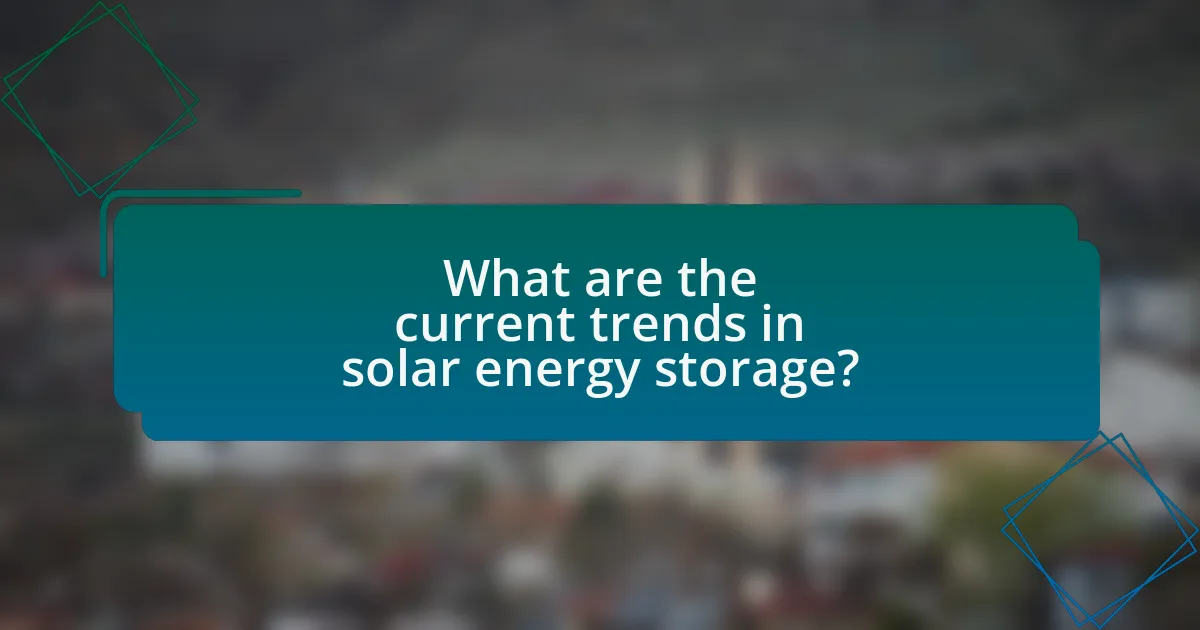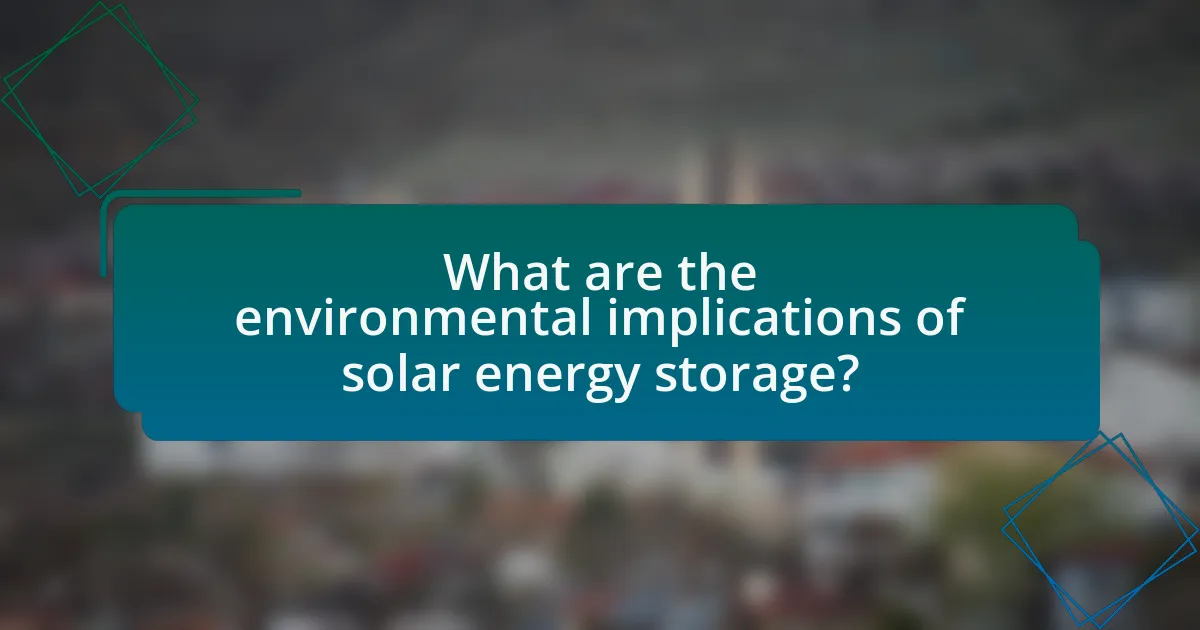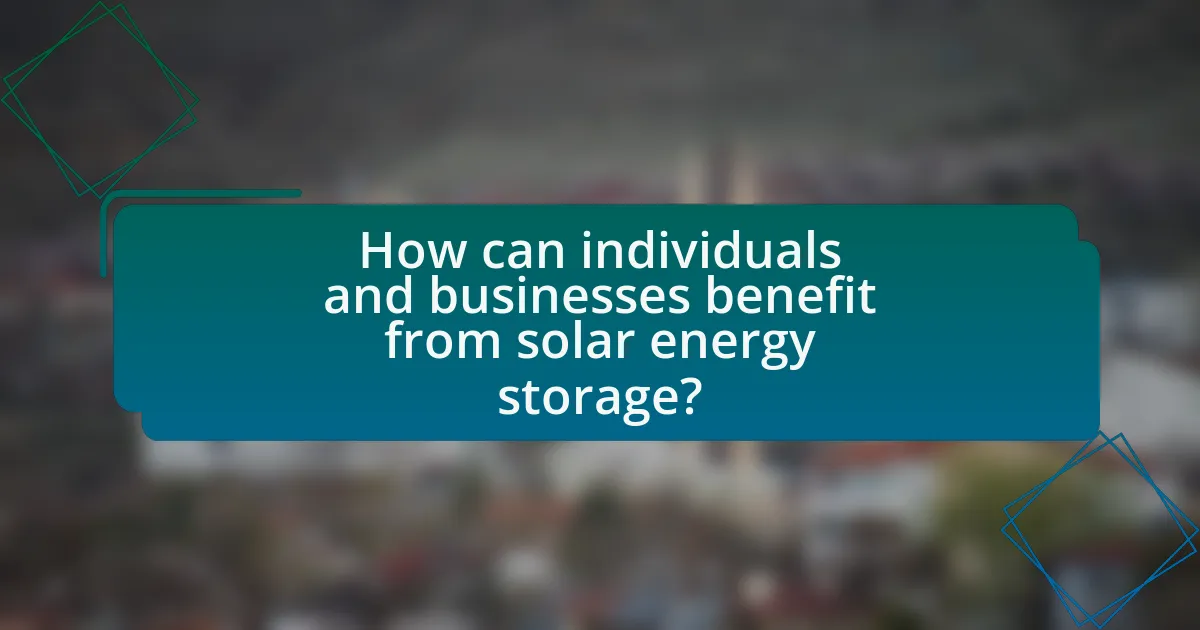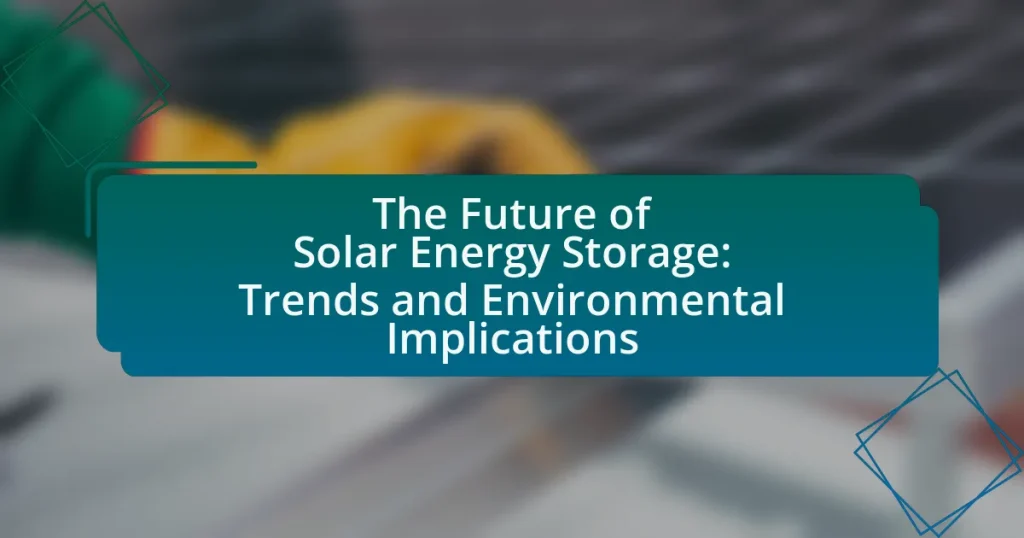The article focuses on the future of solar energy storage, highlighting current trends, technological advancements, and environmental implications. Key trends include the rise of lithium-ion and solid-state batteries, the integration of artificial intelligence for energy management, and the impact of government policies and incentives on adoption rates. The article also examines innovations in materials that enhance efficiency, the lifecycle environmental impacts of solar batteries, and the financial advantages for individuals and businesses investing in solar storage systems. Additionally, it addresses the challenges of recycling and the potential risks associated with solar energy storage, providing a comprehensive overview of the evolving landscape in this sector.
What are the current trends in solar energy storage?


Current trends in solar energy storage include the increasing adoption of lithium-ion batteries, advancements in solid-state battery technology, and the integration of artificial intelligence for energy management. Lithium-ion batteries dominate the market due to their efficiency and decreasing costs, with prices dropping by approximately 89% since 2010, according to BloombergNEF. Solid-state batteries are gaining attention for their potential to offer higher energy densities and improved safety. Additionally, AI is being utilized to optimize energy storage systems, enhancing performance and reducing operational costs. These trends reflect a shift towards more efficient, safer, and cost-effective solar energy storage solutions.
How is technology evolving in solar energy storage systems?
Technology in solar energy storage systems is evolving through advancements in battery chemistry, integration with smart grid technology, and enhanced energy management systems. Recent developments include the use of lithium-sulfur and solid-state batteries, which offer higher energy densities and longer lifespans compared to traditional lithium-ion batteries. For instance, a study published in the journal Nature Energy highlights that lithium-sulfur batteries can potentially achieve energy densities of up to 500 Wh/kg, significantly improving storage capabilities. Additionally, the integration of artificial intelligence in energy management systems allows for optimized energy usage and improved efficiency in solar energy storage, as demonstrated by projects utilizing machine learning algorithms to predict energy demand and supply. These technological advancements are crucial for increasing the reliability and efficiency of solar energy systems, ultimately supporting the transition to renewable energy sources.
What innovations are driving efficiency in solar batteries?
Innovations driving efficiency in solar batteries include advancements in lithium-ion technology, solid-state batteries, and enhanced energy management systems. Lithium-ion batteries have seen improvements in energy density and cycle life, allowing for longer-lasting and more efficient storage solutions. Solid-state batteries, which utilize a solid electrolyte instead of a liquid one, offer higher energy densities and improved safety. Additionally, energy management systems that incorporate artificial intelligence optimize charging and discharging processes, further enhancing overall efficiency. These innovations collectively contribute to more effective solar energy storage, supporting the transition to renewable energy sources.
How do advancements in materials impact solar energy storage?
Advancements in materials significantly enhance solar energy storage by improving efficiency, capacity, and longevity of storage systems. For instance, the development of solid-state batteries, which utilize advanced materials like lithium-sulfur and sodium-ion, allows for higher energy densities compared to traditional lithium-ion batteries. Research indicates that lithium-sulfur batteries can achieve energy densities of up to 500 Wh/kg, which is nearly double that of conventional batteries. Additionally, innovations in phase change materials (PCMs) enable better thermal energy storage, allowing for more effective heat retention and release, thus optimizing solar energy utilization. These material advancements lead to more sustainable and efficient solar energy systems, ultimately supporting the transition to renewable energy sources.
What role do government policies play in solar energy storage trends?
Government policies significantly influence solar energy storage trends by providing financial incentives, regulatory frameworks, and research funding. These policies, such as tax credits and subsidies, lower the cost of solar energy systems and storage technologies, making them more accessible to consumers and businesses. For instance, the Investment Tax Credit (ITC) in the United States allows for a 26% tax credit on solar installations, which has driven market growth and adoption. Additionally, policies that mandate renewable energy standards encourage utilities to invest in energy storage solutions to balance supply and demand. According to the International Energy Agency, supportive government policies have been crucial in increasing global energy storage capacity, which reached 10 gigawatts in 2020, reflecting a growing trend towards integrating solar energy with storage systems.
How are incentives influencing the adoption of solar storage solutions?
Incentives significantly enhance the adoption of solar storage solutions by reducing upfront costs and improving return on investment for consumers. Financial incentives, such as tax credits, rebates, and grants, lower the initial financial barrier, making solar storage systems more accessible. For instance, the Federal Investment Tax Credit (ITC) allows homeowners to deduct a percentage of the cost of solar systems from their federal taxes, which has been shown to increase installation rates. According to the Solar Energy Industries Association, the ITC has contributed to a 167% increase in solar installations from 2016 to 2020. Additionally, state-level incentives and net metering policies further encourage adoption by allowing users to sell excess energy back to the grid, thus enhancing the economic viability of solar storage solutions.
What regulations are shaping the future of solar energy storage?
Regulations shaping the future of solar energy storage include the Federal Energy Regulatory Commission’s Order 841, which mandates that energy storage resources be allowed to participate in wholesale electricity markets. This regulation aims to enhance competition and efficiency in energy markets by ensuring that storage can provide services such as frequency regulation and capacity. Additionally, state-level policies, such as California’s Self-Generation Incentive Program, incentivize the installation of energy storage systems, promoting renewable energy integration and grid resilience. These regulations collectively support the growth of solar energy storage by facilitating market access and providing financial incentives for adoption.
What are the environmental implications of solar energy storage?


The environmental implications of solar energy storage include reduced greenhouse gas emissions and potential ecological impacts from battery production and disposal. Solar energy storage systems, such as lithium-ion batteries, enable the efficient use of renewable energy, decreasing reliance on fossil fuels and lowering carbon footprints. However, the extraction of raw materials like lithium and cobalt for these batteries can lead to habitat destruction and water pollution. Additionally, improper disposal of batteries poses risks of soil and water contamination. According to a study by the International Energy Agency, transitioning to renewable energy storage can significantly mitigate climate change effects, but it is crucial to manage the lifecycle of storage technologies to minimize their environmental footprint.
How does solar energy storage contribute to sustainability?
Solar energy storage significantly contributes to sustainability by enabling the efficient use of renewable energy, reducing reliance on fossil fuels, and minimizing greenhouse gas emissions. By storing excess solar energy generated during peak sunlight hours, energy storage systems allow for its use during periods of low sunlight or high demand, thus optimizing energy consumption. According to the International Renewable Energy Agency, integrating energy storage with solar power can increase the share of renewables in the energy mix, leading to a more resilient and sustainable energy system. This transition not only supports energy independence but also helps mitigate climate change impacts by decreasing carbon footprints associated with traditional energy sources.
What are the lifecycle environmental impacts of solar batteries?
The lifecycle environmental impacts of solar batteries include resource extraction, manufacturing emissions, usage efficiency, and end-of-life disposal challenges. Resource extraction for materials like lithium, cobalt, and nickel can lead to habitat destruction and water pollution. Manufacturing processes contribute to greenhouse gas emissions and energy consumption. During usage, solar batteries can enhance energy efficiency and reduce reliance on fossil fuels, but their performance can vary based on technology and conditions. At the end of their lifecycle, improper disposal can result in toxic waste, while recycling can mitigate some environmental impacts by recovering valuable materials.
How does solar energy storage reduce carbon emissions?
Solar energy storage reduces carbon emissions by enabling the use of renewable energy during peak demand times, thereby decreasing reliance on fossil fuels. When solar energy is stored in batteries or other systems, it can be utilized when sunlight is not available, such as at night or during cloudy days. This shift minimizes the need for carbon-intensive energy sources, which are typically used to meet high energy demands. According to the International Energy Agency, integrating energy storage with solar power can lead to a reduction of up to 1.5 gigatons of CO2 emissions annually by 2040, highlighting the significant impact of solar energy storage on lowering carbon footprints.
What are the potential risks associated with solar energy storage?
The potential risks associated with solar energy storage include battery degradation, fire hazards, and environmental concerns related to battery disposal. Battery degradation occurs over time, reducing efficiency and lifespan, which can lead to increased costs and resource consumption. Fire hazards can arise from improper installation or malfunctioning batteries, posing safety risks to users and property. Additionally, the disposal of batteries, particularly lithium-ion types, raises environmental concerns due to toxic materials that can leach into soil and water if not managed properly. These risks highlight the importance of safe practices and advancements in technology to mitigate negative impacts.
How do hazardous materials in batteries affect the environment?
Hazardous materials in batteries negatively impact the environment by contaminating soil and water sources. When batteries are improperly disposed of, substances like lead, cadmium, and lithium can leach into the ground, leading to toxic exposure for ecosystems and human health. For instance, lead exposure can cause neurological damage in wildlife and humans, while cadmium can accumulate in the food chain, posing risks to various species. Additionally, lithium mining can result in significant water depletion and pollution, affecting local habitats. These environmental consequences highlight the importance of proper battery recycling and disposal methods to mitigate harmful effects.
What are the challenges of recycling solar storage systems?
Recycling solar storage systems faces several challenges, primarily due to the complex materials involved and the lack of established recycling processes. The batteries used in solar storage, such as lithium-ion, contain hazardous materials that require specialized handling to prevent environmental contamination. Additionally, the recycling infrastructure for these systems is not yet fully developed, leading to inefficiencies and increased costs. According to a report by the International Renewable Energy Agency, only about 5% of lithium-ion batteries are currently recycled, highlighting the urgent need for improved recycling technologies and policies to manage the growing volume of solar storage waste effectively.
How can individuals and businesses benefit from solar energy storage?


Individuals and businesses can benefit from solar energy storage by enhancing energy independence and reducing electricity costs. Solar energy storage systems allow users to store excess energy generated during peak sunlight hours for use during periods of low sunlight or high demand, effectively optimizing energy consumption. According to the U.S. Department of Energy, energy storage can reduce reliance on the grid, leading to lower utility bills and increased resilience against power outages. Additionally, businesses can leverage solar energy storage to manage energy costs more effectively, particularly during peak pricing periods, which can result in significant savings over time.
What are the financial advantages of investing in solar energy storage?
Investing in solar energy storage offers significant financial advantages, including reduced energy costs and increased energy independence. By storing excess solar energy for use during peak demand times, homeowners and businesses can lower their electricity bills, as they rely less on grid power, which is often more expensive during high-demand periods. Additionally, solar energy storage systems can provide backup power during outages, reducing the financial impact of lost productivity or damage from power interruptions.
Furthermore, various incentives and rebates are available for solar energy storage installations, which can offset initial investment costs. For instance, the Federal Investment Tax Credit allows for a tax credit of 26% of the total system cost, making the investment more financially viable. According to a report by the U.S. Department of Energy, energy storage can lead to savings of up to $1,000 per year for residential users, demonstrating the long-term financial benefits of such investments.
How does solar energy storage enhance energy independence?
Solar energy storage enhances energy independence by allowing individuals and communities to store excess solar power generated during the day for use during periods of low sunlight or high demand. This capability reduces reliance on external energy sources, such as fossil fuels or grid electricity, thereby increasing self-sufficiency. For instance, a study by the National Renewable Energy Laboratory found that integrating energy storage with solar systems can lead to a 30% reduction in energy costs and significantly lower greenhouse gas emissions. By utilizing stored solar energy, users can maintain power during outages and mitigate the impact of fluctuating energy prices, further solidifying their energy independence.
What are the long-term savings associated with solar storage systems?
Long-term savings associated with solar storage systems primarily stem from reduced electricity bills and increased energy independence. By storing excess solar energy generated during the day, homeowners can utilize this energy during peak hours when electricity rates are higher, leading to significant cost savings over time. According to the U.S. Department of Energy, homeowners can save between $10,000 to $30,000 over 20 years by integrating solar storage with their solar panel systems. Additionally, solar storage systems can enhance property value, as homes equipped with these technologies are often more attractive to buyers, further contributing to long-term financial benefits.
What best practices should be followed when implementing solar energy storage?
When implementing solar energy storage, best practices include selecting the appropriate battery technology, ensuring proper system sizing, and integrating advanced monitoring systems. Choosing the right battery technology, such as lithium-ion or flow batteries, is crucial as it affects efficiency, lifespan, and cost. Proper system sizing ensures that the storage capacity matches energy production and consumption patterns, optimizing performance and reducing waste. Integrating advanced monitoring systems allows for real-time data analysis, enabling better management of energy flow and enhancing system reliability. These practices are supported by industry standards and research, which indicate that effective implementation can significantly improve the efficiency and sustainability of solar energy systems.
How can users optimize the performance of their solar storage systems?
Users can optimize the performance of their solar storage systems by implementing regular maintenance, utilizing advanced battery management systems, and ensuring proper sizing of the storage capacity. Regular maintenance, such as cleaning solar panels and checking connections, enhances efficiency and prolongs system life. Advanced battery management systems monitor battery health and optimize charging cycles, which can improve overall performance and lifespan. Proper sizing of the storage capacity ensures that users can store enough energy to meet their needs without overloading the system, which can lead to inefficiencies and reduced performance.
What maintenance tips are essential for solar energy storage longevity?
To ensure the longevity of solar energy storage systems, regular maintenance is essential. Key maintenance tips include monitoring battery health through periodic checks of voltage and temperature, ensuring proper ventilation to prevent overheating, and keeping the storage area clean and free from debris. Additionally, performing regular inspections for corrosion and ensuring connections are tight can prevent performance issues. Research indicates that maintaining optimal operating conditions can extend battery life by up to 30%, highlighting the importance of these practices.


